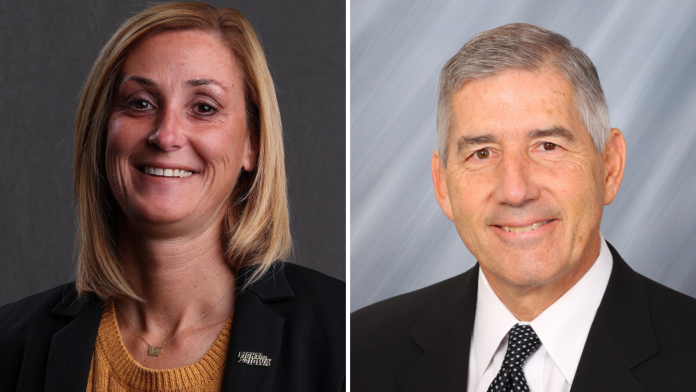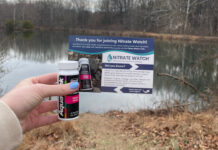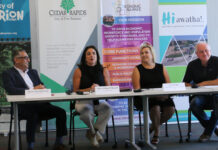
On this special episode of Real Success, I sat down at the Iowa Athletic Club for a live podcast recording with Bob Bowlsby and Beth Goetz, who both have incredible careers in athletics and happen to represent two generations who have taken on the role of athletics director of the University of Iowa.
Bob Bowlsby served as the fourth commissioner of the Big 12 Conference from 2012 to 2022. Prior to that position, he served as the athletics director at the University of Northern Iowa, University of Iowa, and Stanford University.
Beth Goetz is the newly appointed athletics director at the University of Iowa, but has been with the department since 2022. She previously was the athletics director at Ball State University from 2018 to 2022.
Bob and Beth explore the differences between Bob’s time as Iowa’s athletics director back in 1990 and Beth’s early experience in the role, how Beth is approaching a new strategic planning process, and the two dig into the changing landscape of college athletics, including the repercussions of NIL (Name, Image, Likeness). Additionally, Beth touches on long-term facility plans at Iowa, both share their thoughts on the deep partnership universities need to have with their communities, and both Bob and Beth take a turn praising Iowa’s most exciting current player, Caitlin Clark.
I learned a lot, and I think you will too.
Sponsored by MidWestOne Bank, this is the latest edition of the CBJ’s new podcast feature with Nate Kaeding and notable Iowa business and cultural leaders, available first to CBJ members. Listen to this episode below, and subscribe on Spotify, iTunes, Google Play, Stitcher.
Nate Kaeding: Bob, I wanted to start with you. 1990 was the first year you were here as the University of Iowa athletics director, and Beth here is just one month into her tenure. Take us back to 1990. What were some of the challenges you faced? What were you most excited about as you were getting going?
Bob Bowlsby: Well, it was a very different environment than what I had at UNI. We were a fledgling Division 1 program there. Everything was new and fresh, and nobody really expected much of us. When I came to Iowa, it was a fully mature program. We had coaches that had been here a long time that were very well established, and so it was a different job. [At UNI,] we scrambled to sell every ticket that we could possibly sell and to get every donor that we could possibly get. But it seemed easy when you came to Iowa. The game is at one o’clock, you all come and the stadium’s full, and it was similarly fairly easy to raise money. But it has its own complexities. If I had any advice for Beth, it would be to get out before it’s too late.
No, I treasure my years at UNI and I treasure my years at Iowa. In both cases, I had the pleasure of working with extraordinary people — lots of great, young people like you, Nate. The relationships were the same at both places. They’re great cultures of doing things the right way. Probably the hardest decision I ever made in my career was to leave and go to Stanford. I had been recruited by Duke during the middle of my tenure at Iowa and had always had a curiosity about the elite private school environment. Stanford, of course, had previously had extraordinary success. So I am glad that I went, but it was amazingly difficult to do that and leave a place where my first job in my entire life was selling soft drinks at Kinnick Stadium. It took me years to figure out why people bought a perfectly good drink and dumped half of it out.
Beth, Bob says that you should get out now, but we’re not letting you go. You’ve signing on the dotted line and you’re here. So talk a bit about your first month, what your schedule’s been like, and everything that’s been on your radar.
Beth Goetz: Well, first of all, you hit the nail on the head. At the end of the day, it’s always about the people. I think, when I first got here about 16 months ago, it only took about 10 minutes before I could just feel this overwhelming sense of community. It’s so personal for everyone, and I think you feel that right away. So it’s been a wonderful opportunity to be a part of that in the last month or so, as we obviously dial in on what we want to do and need to do here to support our student athletes while also being really mindful about what’s going on in the industry. That takes up a lot of time to make sure we can continue to keep the focus where it should be, which is giving these young people great opportunities so that they can come back to our communities and do great things like you are, Nate.
As a new athletics director, do you take the organization through a new strategic planning process? How do you “vision out,” beyond year one, the immediate challenges and goals in the future?
Beth: Yeah, we will do that. Certainly part of that is new leadership, but part of that just is this moment in time. I think there’s going to be some shifting that we need to do all across the industry, but I do think it’s the right time to look across the board and say, “Hey, how do we continue to leverage the strengths we have and support our coaches while recognizing that we have some Hall of Fame coaches and we may not be able to keep them here for another 10 or 15 years, so what does the transition plan look like there? How do we successfully navigate, in the best way Iowa can, what’s coming in the national landscape and continue to have great championship opportunities across all sports?” That definitely will lead to a strategic planning process that we’ll do over the next year.
One of the big things is the conference realignment with welcoming Washington and others into the conference. I’m curious from both of your perspectives: Bob, where does that leave some of our smaller Division 1 schools? Then Beth, tell us a bit about the Big 10 and what we should all expect as fans. Bob, do you want to go first?
Bob: Well, the landscape is changing and there’s never been a more difficult time to be a director of athletics on campus. Relative to the landscape, there’s just a lot of things that are in play right now that we’ve never experienced before.
I spent two years chairing an NCAA committee on name, image and likeness, and we probably had a dozen guardrails that we were prepared to put into place when this was going to start. Principal among them was that NIL was not to be used as an inducement for transfer or initial enrollment. It was quite clear there was a fair amount of transparency in the model. Student athletes would be able to teach lessons for fees, to give speaking engagements for compensation, to sign autographs for money, or run their own camps and clinics if they wanted to. They would’ve been able to have an agent and have a financial manager. It was a very substantial liberalization of what was permissible.
But the NCAA refused to put it in place. Their legal counsel said, “We’re going to get sued again.” Of course, all of us knew we were going to get sued again, but we would have had a stake in the ground that articulated what we stood for. Instead, we now have 25 states that have no laws. We have 25 states that have a wide-ranging array of laws that are incompatible with one another, and we have no NCAA rule upon which any of us can rely. So it’s a fair question to ask whether or not we can get the genie back in the bottle at this point.
It’s a very difficult environment. We are very close to a pay-for-play environment and largely, from the UNI perspective, we’re below the fray. The practical effect is that you’ll see the better program stockpiling the better players. It’s enormously complex and we’re right in the middle of it, but I will say after a long period of watching it, intercollegiate athletics and higher education has a way of finding its equilibrium. I think we will find equilibrium. Is it going to go back to where it was before or anything that really looks like it? I doubt it, but I think we’ll find equilibrium.
Beth: That was an incredible summary. I think, at the end of the day, the best thing we all can do now is to acknowledge that the system has to look a little bit different. We’ve got to reconcile the business side of Division 1 athletics with the benefits that we provide to students and figure out what that looks like. I think the exciting part of that for most of us, which maybe sounds a little naive, is the great experiences student athletes have, and I don’t know that one experience is better based on the number of shoes we have or the amount of money in our pocket.
We can debate for days about what the framework should be, but we can’t be in this cycle of just having to be responsive. That’s sort of where we have found ourselves. We’ve got all these antitrust issues. “Wild West” is the word that our coaches are all using, to be sure. How do we get some framework that allows an equilibrium to set? We all have to figure out how to navigate what that new landscape looks like in the way that’s best for who we are, not what’s best for one of our peers. We’ll leverage our strengths and then we’ll all find our own path forward.
Beth, tell us about the long-term facilities plan for the University of Iowa and the athletics department?
Beth: Yeah, we’ve got a few short-term projects that are already in progress and a few we’re hoping we can launch here shortly, but the Goschke Family Wrestling Practice Facility will open up here in April. It is going to be literally one of the best in the world and certainly the best here in the United States. So that’s going to serve both of our programs. We’re really excited about that. We’ve broken ground on a new gymnastics and spirit squad facility thanks to some generous philanthropic support. We’ve got some plans to make some improvements to the baseball stadium. I think most people have heard me start to talk a little bit about Carver-Hawkeye Arena. It’s a beautiful facility that’s 41 years old, and we need to make sure we can utilize that for the next 40 years. So I’m excited about what that could look like.
Beth, talk a little bit about Caitlin Clark and how, as her star has risen, the athletics department and the university has supported her.
Beth: What’s remarkable about her is that she raised everyone else’s star along with her. That is certainly true for her teammates, but also what she’s done for our university, for our state, and for the game of women’s basketball. She’s so intentional about being a great ambassador. It is really important, when you have somebody with that profile, that we do all we can to support her, and it’s not just the university. Our community has done everything they can to help support her and her family.
You’re talking about a college student that can’t really walk from one building to the other without a crowd around her, and that’s a lot, even though she is so generous with her time. How do you navigate that? So we’re making sure that we have a great security plan on our campus and on the road. It’s a really cooperative effort that has to happen with their security team. We do travel with them and advance some of them out front to make sure they’re locking down hotels. We understand who’s in and out. Most of the time it’s just fans and young people wanting to be around her, but you’ve got to be really careful. So whether it’s providing that type of support, or working closely with her family and others that support all the things and agreements that she has going around, that’s all certainly our priority.
Bob: Yeah, I think that she’s certainly at least a generational talent. There’s no question about that. I couldn’t name another person that’s had the kind of playing impact that she has had, but what’s been impressive is the manner in which she’s handled it. There are people watching women’s basketball that never considered it in the past. The fact that she’s humble and giving and engaged with everything you’d want her to be engaged with, it’s a dream come true for an athletics director and a coach. It takes a special coach to be able to handle it, too.
Can you speak a little bit to what that athletics department needs in terms of support from their local community?
Bob: I think the public/private partnerships that are now becoming more popular and more doable perhaps have never been more important than they are right now. Higher education is under extreme pressure, not just in the state of Iowa, but for the first time in history higher education is enduring a less than 50% approval rating from the general public. As Beth mentioned, fewer and fewer males are attending college. Universities are typically among the largest employers in the area, if not the largest. So there’s never been a better time for these partnerships. Yet, from the university perspective, we tend not to be very good partners because we’re rigid, we’ve got lots of state rules, and we have things that are impediments to real partnerships. I don’t think higher education is going to get any easier. I think it’s going to continue to trend in the direction it has.
Beth: From the athletics department’s standpoint, we have the visibility and the platform to help. I think it’s important to continue to do that and to really say, “Hey, what do we need in our communities and what roles can we all play?” Because, at the end of the day, what we want to make sure of is that we’re providing a great quality of life access to things that people need, which not only means entertainment in our case, but health care and all these other components that would be fulfilling. To do that, it’s going to require difficult conversations, partnerships, and trying to figure out how you can move forward together.




